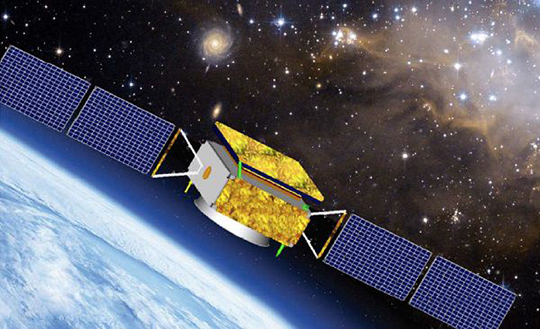


[File photo]
China’s first dark matter probe satellite had explored 1.6 billion particles by Nov. 10, 328 days after the detector started to search the signals of invisible material.
The satellite, named "Wukong" after the Monkey King character in the Chinese classic "Journey to the West," was launched on Dec. 17, 2015 using a Long March 2-D rocket from Jiuquan Satellite Launch Center in Gansu province. The satellite boasts the largest observation scope, as well as the best energy resolution ratio and particle-resolving ability worldwide.
Recently, the satellite’s orbital height has remained stable at around 504 kilometers. Its remote control and load temperature are also in the normal range. Wu Jian, head engineer of the satellite, explained that researchers have revised the data calibration and templates over 4,600 times in order to guarantee precision.
The satellite sent back its first set of observation data several minutes after its operation commenced; its performance has only improved since then. The satellite won recognition from a number of assessment experts thanks to its in-orbit test three months after launching.
Chief scientist Chang Jin said that the satellite focuses on precise detection, high efficiency and low cost. Considering the data, Chang expressed his belief that a breakthrough, adding “Chinese power” to the development of space science, was not far away.
 Fire brigade in Shanghai holds group wedding
Fire brigade in Shanghai holds group wedding Tourists enjoy ice sculptures in Datan Town, north China
Tourists enjoy ice sculptures in Datan Town, north China Sunset scenery of Dayan Pagoda in Xi'an
Sunset scenery of Dayan Pagoda in Xi'an Tourists have fun at scenic spot in Nanlong Town, NW China
Tourists have fun at scenic spot in Nanlong Town, NW China Harbin attracts tourists by making best use of ice in winter
Harbin attracts tourists by making best use of ice in winter In pics: FIS Alpine Ski Women's World Cup Slalom
In pics: FIS Alpine Ski Women's World Cup Slalom Black-necked cranes rest at reservoir in Lhunzhub County, Lhasa
Black-necked cranes rest at reservoir in Lhunzhub County, Lhasa China's FAST telescope will be available to foreign scientists in April
China's FAST telescope will be available to foreign scientists in April "She power" plays indispensable role in poverty alleviation
"She power" plays indispensable role in poverty alleviation Top 10 world news events of People's Daily in 2020
Top 10 world news events of People's Daily in 2020 Top 10 China news events of People's Daily in 2020
Top 10 China news events of People's Daily in 2020 Top 10 media buzzwords of 2020
Top 10 media buzzwords of 2020 Year-ender:10 major tourism stories of 2020
Year-ender:10 major tourism stories of 2020 No interference in Venezuelan issues
No interference in Venezuelan issues
 Biz prepares for trade spat
Biz prepares for trade spat
 Broadcasting Continent
Broadcasting Continent Australia wins Chinese CEOs as US loses
Australia wins Chinese CEOs as US loses